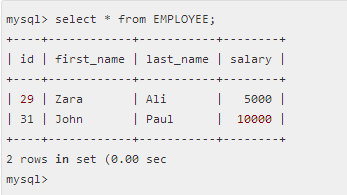拦截器
你已经学到,在 Hibernate 中,一个对象将被创建和保持。一旦对象已经被修改,它必须被保存到数据库里。这个过程持续直到下一次对象被需要,它将被从持久的存储中加载。
因此一个对象通过它生命周期中的不同阶段,并且 Interceptor 接口提供了在不同阶段能被调用来进行一些所需要的任务的方法。这些方法是从会话到应用程序的回调函数,允许应用程序检查或操作一个持续对象的属性,在它被保存,更新,删除或上传之前。以下是在 Interceptor 接口中可用的所有方法的列表。
| S.N. | 方法和描述 |
|---|---|
| 1 | findDirty() 这个方法在当 flush() 方法在一个 Session 对象上被调用时被调用。 |
| 2 | instantiate() 这个方法在一个持续的类被实例化时被调用。 |
| 3 | isUnsaved() 这个方法在当一个对象被传到 saveOrUpdate() 方法时被调用。 |
| 4 | onDelete() 这个方法在一个对象被删除前被调用。 |
| 5 | onFlushDirty() 这个方法在当 Hibernate 探测到一个对象在一次 flush(例如,更新操作)中是脏的(例如,被修改)时被调用。 |
| 6 | onLoad() 这个方法在一个对象被初始化之前被调用。 |
| 7 | onSave() 这个方法在一个对象被保存前被调用。 |
| 8 | postFlush() 这个方法在一次 flush 已经发生并且一个对象已经在内存中被更新后被调用。 |
| 9 | preFlush() 这个方法在一次 flush 前被调用。 |
Hibernate 拦截器给予了我们一个对象如何应用到应用程序和数据库的总控制。
如何使用拦截器?
为了创建一个拦截器你可以直接实现 Interceptor 类或者继承 EmptyInterceptor 类。以下是简单的使用 Hibernate 拦截器功能的步骤。
创建拦截器
我们将在例子中继承 EmptyInterceptor,当 Employee 对象被创建和更新时拦截器的方法将自动被调用。你可以根据你的需求实现更多的方法。
import java.io.Serializable; import java.util.Date; import java.util.Iterator; import org.hibernate.EmptyInterceptor; import org.hibernate.Transaction; import org.hibernate.type.Type; public class MyInterceptor extends EmptyInterceptor { private int updates; private int creates; private int loads; public void onDelete(Object entity, Serializable id, Object[] state, String[] propertyNames, Type[] types) { // do nothing } // This method is called when Employee object gets updated. public boolean onFlushDirty(Object entity, Serializable id, Object[] currentState, Object[] previousState, String[] propertyNames, Type[] types) { if ( entity instanceof Employee ) { System.out.println("Update Operation"); return true; } return false; } public boolean onLoad(Object entity, Serializable id, Object[] state, String[] propertyNames, Type[] types) { // do nothing return true; } // This method is called when Employee object gets created. public boolean onSave(Object entity, Serializable id, Object[] state, String[] propertyNames, Type[] types) { if ( entity instanceof Employee ) { System.out.println("Create Operation"); return true; } return false; } //called before commit into database public void preFlush(Iterator iterator) { System.out.println("preFlush"); } //called after committed into database public void postFlush(Iterator iterator) { System.out.println("postFlush"); } }
创建 POJO 类
现在让我们稍微修改我们的第一个例子,我们使用 EMPLOYEE 表单和 Employee 类:
public class Employee { private int id; private String firstName; private String lastName; private int salary; public Employee() {} public Employee(String fname, String lname, int salary) { this.firstName = fname; this.lastName = lname; this.salary = salary; } public int getId() { return id; } public void setId( int id ) { this.id = id; } public String getFirstName() { return firstName; } public void setFirstName( String first_name ) { this.firstName = first_name; } public String getLastName() { return lastName; } public void setLastName( String last_name ) { this.lastName = last_name; } public int getSalary() { return salary; } public void setSalary( int salary ) { this.salary = salary; } }
创建数据库表
第二步将是在你的数据库中创建表。一张表对应每个你提供持久性的对象。考虑以上的对象需要被存储和检索到以下的 RDBM 表中:
create table EMPLOYEE ( id INT NOT NULL auto_increment, first_name VARCHAR(20) default NULL, last_name VARCHAR(20) default NULL, salary INT default NULL, PRIMARY KEY (id) );
创建 Mapping 配置文件
这个步骤是来创建一个指导 Hibernate 如何将定义的类或者多个类映射到数据库表单中的映射文件。
<?xml version="1.0" encoding="utf-8"?> <!DOCTYPE hibernate-mapping PUBLIC "-//Hibernate/Hibernate Mapping DTD//EN" "http://www.hibernate.org/dtd/hibernate-mapping-3.0.dtd"> <hibernate-mapping> <class name="Employee" table="EMPLOYEE"> <meta attribute="class-description"> This class contains the employee detail. </meta> <id name="id" type="int" column="id"> <generator class="native"/> </id> <property name="firstName" column="first_name" type="string"/> <property name="lastName" column="last_name" type="string"/> <property name="salary" column="salary" type="int"/> </class> </hibernate-mapping>
创建 Application 类
最后,我们将用 main() 创建 application 类来运行应用程序。这里应该注意当创建 session 对象时我们使用 Interceptor 类作为参数。
import java.util.List; import java.util.Date; import java.util.Iterator; import org.hibernate.HibernateException; import org.hibernate.Session; import org.hibernate.Transaction; import org.hibernate.SessionFactory; import org.hibernate.cfg.Configuration; public class ManageEmployee { private static SessionFactory factory; public static void main(String[] args) { try{ factory = new Configuration().configure().buildSessionFactory(); }catch (Throwable ex) { System.err.println("Failed to create sessionFactory object." + ex); throw new ExceptionInInitializerError(ex); } ManageEmployee ME = new ManageEmployee(); /* Add few employee records in database */ Integer empID1 = ME.addEmployee("Zara", "Ali", 1000); Integer empID2 = ME.addEmployee("Daisy", "Das", 5000); Integer empID3 = ME.addEmployee("John", "Paul", 10000); /* List down all the employees */ ME.listEmployees(); /* Update employee's records */ ME.updateEmployee(empID1, 5000); /* Delete an employee from the database */ ME.deleteEmployee(empID2); /* List down new list of the employees */ ME.listEmployees(); } /* Method to CREATE an employee in the database */ public Integer addEmployee(String fname, String lname, int salary){ Session session = factory.openSession( new MyInterceptor() ); Transaction tx = null; Integer employeeID = null; try{ tx = session.beginTransaction(); Employee employee = new Employee(fname, lname, salary); employeeID = (Integer) session.save(employee); tx.commit(); }catch (HibernateException e) { if (tx!=null) tx.rollback(); e.printStackTrace(); }finally { session.close(); } return employeeID; } /* Method to READ all the employees */ public void listEmployees( ){ Session session = factory.openSession( new MyInterceptor() ); Transaction tx = null; try{ tx = session.beginTransaction(); List employees = session.createQuery("FROM Employee").list(); for (Iterator iterator = employees.iterator(); iterator.hasNext();){ Employee employee = (Employee) iterator.next(); System.out.print("First Name: " + employee.getFirstName()); System.out.print(" Last Name: " + employee.getLastName()); System.out.println(" Salary: " + employee.getSalary()); } tx.commit(); }catch (HibernateException e) { if (tx!=null) tx.rollback(); e.printStackTrace(); }finally { session.close(); } } /* Method to UPDATE salary for an employee */ public void updateEmployee(Integer EmployeeID, int salary ){ Session session = factory.openSession( new MyInterceptor() ); Transaction tx = null; try{ tx = session.beginTransaction(); Employee employee = (Employee)session.get(Employee.class, EmployeeID); employee.setSalary( salary ); session.update(employee); tx.commit(); }catch (HibernateException e) { if (tx!=null) tx.rollback(); e.printStackTrace(); }finally { session.close(); } } /* Method to DELETE an employee from the records */ public void deleteEmployee(Integer EmployeeID){ Session session = factory.openSession( new MyInterceptor() ); Transaction tx = null; try{ tx = session.beginTransaction(); Employee employee = (Employee)session.get(Employee.class, EmployeeID); session.delete(employee); tx.commit(); }catch (HibernateException e) { if (tx!=null) tx.rollback(); e.printStackTrace(); }finally { session.close(); } } }
编译和执行
这里是编译和运行上面提及的应用程序的步骤。确保你已经在处理编译和执行前正确设置了 PATH 和 CLASSPATH。
- 创建在 configuration 章节中解释的 hibernate.cfg.xml 配置文件。
- 创建如上所示的 Employee.hbm.xml 映射文件。
- 创建如上所示的 Employee.java 源文件并编译。
- 创建如上所示的 MyInterceptor.java 源文件并编译。
- 创建如上所示的 ManageEmployee.java 源文件并编译。
- 执行 ManageEmployee 来运行程序。
你将得到以下结果,而且记录将在 EMPLOYEE 表单中被创建。
$java ManageEmployee
.......VARIOUS LOG MESSAGES WILL DISPLAY HERE........
Create Operation
preFlush
postFlush
Create Operation
preFlush
postFlush
Create Operation
preFlush
postFlush
First Name: Zara Last Name: Ali Salary: 1000
First Name: Daisy Last Name: Das Salary: 5000
First Name: John Last Name: Paul Salary: 10000
preFlush
postFlush
preFlush
Update Operation
postFlush
preFlush
postFlush
First Name: Zara Last Name: Ali Salary: 5000
First Name: John Last Name: Paul Salary: 10000
preFlush
postFlush
如果你检查你的 EMPLOYEE 表单,它应该有如下结果:
